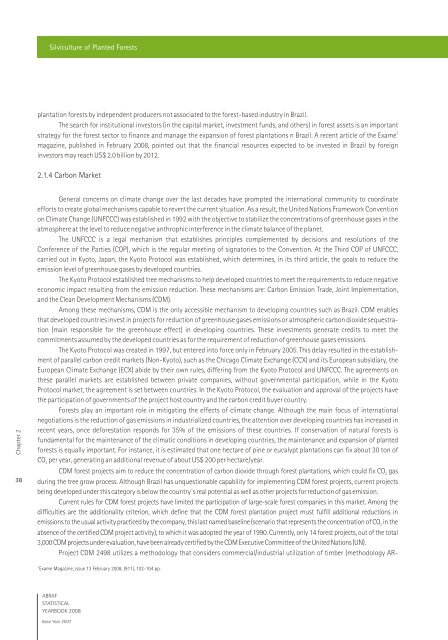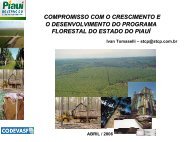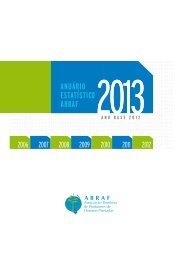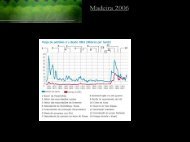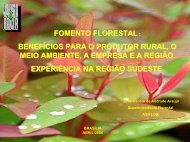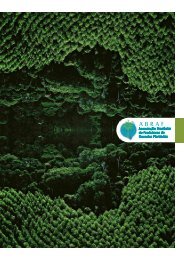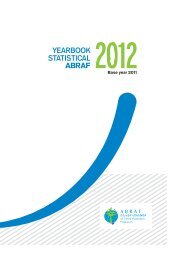ABRAF STATISTICAL YEARBOOK - Associação Brasileira de ...
ABRAF STATISTICAL YEARBOOK - Associação Brasileira de ...
ABRAF STATISTICAL YEARBOOK - Associação Brasileira de ...
You also want an ePaper? Increase the reach of your titles
YUMPU automatically turns print PDFs into web optimized ePapers that Google loves.
Silviculture of Planted Forestsplantation forests by in<strong>de</strong>pen<strong>de</strong>nt producers not associated to the forest-based industry in Brazil.The search for institutional investors (in the capital market, investment funds, and others) in forest assets is an important3strategy for the forest sector to finance and manage the expansion of forest plantations n Brazil. A recent article of the Examemagazine, published in February 2008, pointed out that the financial resources expected to be invested in Brazil by foreigninvestors may reach US$ 2.0 billion by 2012.2.1.4 Carbon MarketChapter 238General concerns on climate change over the last <strong>de</strong>ca<strong>de</strong>s have prompted the international community to coordinateefforts to create global mechanisms capable to revert the current situation. As a result, the United Nations Framework Conventionon Climate Change (UNFCCC) was established in 1992 with the objective to stabilize the concentrations of greenhouse gases in theatmosphere at the level to reduce negative anthrophic interference in the climate balance of the planet.The UNFCCC is a legal mechanism that establishes principles complemented by <strong>de</strong>cisions and resolutions of theConference of the Parties (COP), which is the regular meeting of signatories to the Convention. At the Third COP of UNFCCC,carried out in Kyoto, Japan, the Kyoto Protocol was established, which <strong>de</strong>termines, in its third article, the goals to reduce theemission level of greenhouse gases by <strong>de</strong>veloped countries.The Kyoto Protocol established tree mechanisms to help <strong>de</strong>veloped countries to meet the requirements to reduce negativeeconomic impact resulting from the emission reduction. These mechanisms are: Carbon Emission Tra<strong>de</strong>, Joint Implementation,and the Clean Development Mechanisms (CDM).Among these mechanisms, CDM is the only accessible mechanism to <strong>de</strong>veloping countries such as Brazil. CDM enablesthat <strong>de</strong>veloped countries invest in projects for reduction of greenhouse gases emissions or atmospheric carbon dioxi<strong>de</strong> sequestration(main responsible for the greenhouse effect) in <strong>de</strong>veloping countries. These investments generate credits to meet thecommitments assumed by the <strong>de</strong>veloped countries as for the requirement of reduction of greenhouse gases emissions.The Kyoto Protocol was created in 1997, but entered into force only in February 2005. This <strong>de</strong>lay resulted in the establishmentof parallel carbon credit markets (Non-Kyoto), such as the Chicago Climate Exchange (CCX) and its European subsidiary, theEuropean Climate Exchange (ECX) abi<strong>de</strong> by their own rules, differing from the Kyoto Protocol and UNFCCC. The agreements onthese parallel markets are established between private companies, without governmental participation, while in the KyotoProtocol market, the agreement is set between countries. In the Kyoto Protocol, the evaluation and approval of the projects havethe participation of governments of the project host country and the carbon credit buyer country.Forests play an important role in mitigating the effects of climate change. Although the main focus of internationalnegotiations is the reduction of gas emissions in industrialized countries, the attention over <strong>de</strong>veloping countries has increased inrecent years, once <strong>de</strong>forestation responds for 35% of the emissions of these countries. If conservation of natural forests isfundamental for the maintenance of the climatic conditions in <strong>de</strong>veloping countries, the maintenance and expansion of plantedforests is equally important. For instance, it is estimated that one hectare of pine or eucalypt plantations can fix about 30 ton ofCO per year, generating an additional revenue of about US$ 200 per hectare/year.2CDM forest projects aim to reduce the concentration of carbon dioxi<strong>de</strong> through forest plantations, which could fix CO gas 2during the tree grow process. Although Brazil has unquestionable capability for implementing CDM forest projects, current projectsbeing <strong>de</strong>veloped un<strong>de</strong>r this category is below the country´s real potential as well as other projects for reduction of gas emission.Current rules for CDM forest projects have limited the participation of large-scale forest companies in this market. Among thedifficulties are the additionality criterion, which <strong>de</strong>fine that the CDM forest plantation project must fulfill additional reductions inemissions to the usual activity practiced by the company, this last named baseline (scenario that represents the concentration of CO in the2absence of the certified CDM project activity), to which it was adopted the year of 1990. Currently, only 14 forest projects, out of the total3,000 CDM projects un<strong>de</strong>r evaluation, have been already certified by the CDM Executive Committee of the United Nations (UN).Project CDM 2498 utilizes a methodology that consi<strong>de</strong>rs commercial/industrial utilization of timber (methodology AR-3Exame Magazine, issue 13 February 2008, (911), 102-104 pp.<strong>ABRAF</strong><strong>STATISTICAL</strong><strong>YEARBOOK</strong> 2008Base Year 2007


